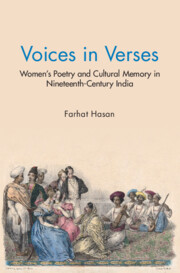Book contents
- Frontmatter
- Dedication
- Contents
- Acknowledgements
- A Note on Transliteration
- List of Abbreviations
- 1 Introduction
- 2 Unravelling the Texts: Memory, Reforms, and Literary Sulh-i-Kul
- 3 Representing an Inclusive Literary Culture: Women Poets in the Bazaars and Kothas
- 4 Representing the Kothas: The Two Sisters in the Literary Sphere
- 5 Commemorating Women Poets: Memory, Gender, and the Literary Culture in the Persianate World
- 6 Secluded Poets in Literary Spaces: Memorializing Female Rulers, Consorts, and Memsahibs
- 7 Conclusion
- Glossary
- Bibliography
- Index
4 - Representing the Kothas: The Two Sisters in the Literary Sphere
Published online by Cambridge University Press: 06 March 2024
- Frontmatter
- Dedication
- Contents
- Acknowledgements
- A Note on Transliteration
- List of Abbreviations
- 1 Introduction
- 2 Unravelling the Texts: Memory, Reforms, and Literary Sulh-i-Kul
- 3 Representing an Inclusive Literary Culture: Women Poets in the Bazaars and Kothas
- 4 Representing the Kothas: The Two Sisters in the Literary Sphere
- 5 Commemorating Women Poets: Memory, Gender, and the Literary Culture in the Persianate World
- 6 Secluded Poets in Literary Spaces: Memorializing Female Rulers, Consorts, and Memsahibs
- 7 Conclusion
- Glossary
- Bibliography
- Index
Summary
In this chapter, we look at, with a focus on two sisters, both courtesans – Zuhra and Mushtari – the meaning of and constraints on the participation of women entertainers in the literary sphere. We hear them ‘speak’ and from their speech-acts explore their construction of selfhood, articulation of subjectivities, and resistance to dominant social and literary norms. At the same time, we make an effort to unravel the anxieties that their literary talents evoked in the sociocultural spaces, and the reasons for their immense popularity in social memory. We also ask how their agency in the cultural domain was represented in the literary sphere, in particular the biographical compendia of the time.
The Courtesans as Models of Literary Emulation: The Pre-eminence of the Sisters in Cultural Spaces
Why these sisters? My reason for choosing them is because their literary acumen was widely accepted, and critics often measured the compositions of other women poets against the depth and range of their poems. The sisters had, it seems, set the standards that other poets were expected to aspire to and emulate. Nazakat, ‘an endearing public performer’ (mahbūba-i bāzārī) based in Bombay, wrote a couplet and a ghazal as an accompaniment to (and in the same meter as) one of the poems of Mushtari; comparing her effort with the literary skills of the two sisters, Nadir found her endeavour no more than ‘meaningless verbosity’ (tūl-i fazūl), and decided not to include the ghazal in his tazkira. Ranj was blunt, and saw her attempt to imitate Mushtari as ridiculous. He says:
She [Nazakat] wrote this ghazal which she visualized as an aesthetic response to one of the poems of Mushtari Lucknawi. How can the Sun be compared with a tiny particle (kahān zarrah kahān āftāb)? How can the shoddy distich (bhadde ash‘ār) of Nazakat be an answer to the ghazals of Mushtari?
In the case of another courtesan by the same name, Nazakat, Ranj expressed his appreciation of her poetry by comparing her with Mushtari (and Sardar). This courtesan, based in Jaipur, could, says Ranj, get the likes of Mushtari envious. Clearly then, in matters of literary expression and aesthetics, Mushtari, and her sister, Zuhra, were held out as models against whom other poets were assessed, and their compositions evaluated.
- Type
- Chapter
- Information
- Voices in VersesWomen's Poetry and Cultural Memory in Nineteenth-Century India, pp. 91 - 117Publisher: Cambridge University PressPrint publication year: 2024

